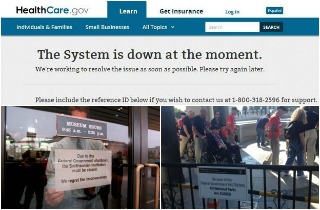Obama’s “Signature” Achievement May Have Signed Its Death Warrant
Trouble beyond the easy fixes Oct 24 2013Republicans have for weeks been calling the Affordable Care Act a “train wreck” well before it had even left the station but the sputtering October 1 debut made it clear that Obama doesn’t know how to run the railroad.
You’ve got to wonder, how could the President have paid so little attention to the status of what is endlessly called his “signature” achievement that he would say on the same day the government’s Internet insurance exchange crashed that people will be able to shop "the same way you'd order a plane ticket on Kayak or a TV on Amazon".

Instead, the insurance "marketplace" was let loose for the entire country to beta test, but Obama has "brought in some of the best IT experts from across the country" to deal with the emergency, says a White House e-mail, experts who should have been involved from the beginning. Almost three weeks after launch, Obama said in a Rose Garden appearance, "Nobody's madder than me about the fact that the website isn't working as well as it should, which means, it's gonna get fixed", as if the commander in chief can simply order millions of lines of code to rearrange themselves. Most predictions expect that repairs will take weeks. Our forecast is months, and that could bring Obamacare down.
Did Obama simply take the word of equally non-technical Health & Human Services (HHS) chief Kathleen Sebelius (a former governor) that “we’re on target”, as she said in a July interview after months of “projecting optimism and confidence”?

Sebelius would soon exhibit cluelessness of her own. A week after the government’s exchange opened, when asked by Jon Stewart on the Daily Show, "How many have signed up thus far?”, she answered, “Fully enrolled, I can’t tell you. I don’t know”. We are now told that in the months before the system would debut, she reportedly misallocated her time traveling the country to promote it, instead of constantly monitoring the progress of the hugely complex system, which could have headed off the disastrous launch. There are calls for madam secretary to resign, as the one ultimately responsible for the botched system, but Obama cannot allow that. Republicans in the Senate would block any nominee he put forward, leaving the department headless.
Fourteen states either couldn’t be bothered to roll their own system or preferred to undermine Obamacare by not cooperating, leaving the federal government to handle the exchanges for the rest of the states. Visions of deluge should have panicked the Obama administration. Ms Sebelius said that the website’s inability to handle the load would not have occurred “unless millions of people flooded the marketplace”. Surprise! There are millions in the 36 states. So there were 9.5 million visitors in the first week and 4.1 million in the second.
States were better prepared. New York dealt with about 2 million visits in its first 90 minutes; California recorded 5 million on opening day. The HHS secretary belatedly concluded, “We didn’t have enough testing, specifically for high volumes, for a very complicated project.” Ya think?
Months before, they could have found a hacker to launch a distributed denial-of-service attack to bombard the prototype exchange website with increasing loads of millions of logon to reveal at what point the system breaks. They would have discovered well in advance that another warehouse of servers was needed.
Actually, Secretary Sebelius did say that the system had been stress tested. They had set the bar at five times the highest volume that the Medicare.gov website had ever experienced. But Medicare’s universe is only a slice of the population, and when would millions of seniors have had cause to rush that mature system to make for a comparable peak day?
Capacity was only the first problem to surface. USA Today quoted several experts who found evidence of what they said looked like 10-year old web technology, although some of their expertise seems a bit ancient itself, as with one expert’s suggestion that, "If I was them [sic], and I'm just conjecturing, I would probably come up with some manual way of saying, 'Only people with the last name starting with 'A' can sign up today".
remember ‘user friendly’?Once inside the system, applicants were forced to set up an account before they even decided whether or not they were customers. There was no ability to browse the offerings. That says there was no move to draw on the wealth of technical and marketing savvy of online sellers like Amazon, or to learn from Massachusetts' “Romneycare”, which could have told the system architects that people in that state went online 18 times before they bought insurance. People shop before they buy. At least that design flaw was quickly fixed.
coding confusionFurther in, applicants found a loosely coded site that lacked error checking. One could enter multiple spouses, could list spouses as children, could sign up for more than one plan, could even change someone else's data, could enroll more than once — which happened often when users repeatedly hit the “Submit” button in the unresponsive system.
Much of this is attributable to reports that government officials made constant changes requiring re-writing of code which foreshortened the time remaining for testing in the months leading to the October 1 deadline.
One consequence is flawed data being handed to the insurance companies that are “straining their ability to handle even the trickle of enrollees who have gotten through so far”. Insurers are finding they have to correct a high percentage of submissions manually and even hire temporary workers to phone applicants. They fear an inability to handle the load once the current trickle turns into a flood.
Their bigger worry is that if system problems cannot be rapidly corrected, only the sickest will persevere to buy insurance, whereas the young and healthy — whose participation is key to offsetting the cost of those with illnesses — will give it a try but not come back.
original sinHHS let the principal contract to the U.S. arm of a Canadian company to create the system. The original bid was $55.7 million, with a cap of $94 million. But those numbers expanded grotesquely, evidencing how badly both the agency and the company underestimated the task before them. Ultimately, $394 million was spent, according to the Associated Press.
The government unaccountably failed to tap the best developers of Internet technology, instead contracting with a company that calls itself an “information technology and business process services firm”, which sounds more like a back office mainframe shop. The hundreds of millions spent on a flawed system bring to mind the decade-long $450 million FBI attempt to modernize its system. Was the HHS the victim of lowest bidder rules and made to chose the wrong supplier?
tangled webWhen Congress creates laws, its members seem utterly unmindful and unconcerned for how those laws will be implemented. That is certainly the case with the Affordable Care Act, routinely spoken of as 2,200 pages that no one in Congress ever read (actually, that would be the double-spaced original; the law, as passed, runs to 906 pages and can be found here). Like tax law, it is larded with requirements, many of which are inconsequential, simply adding to complexity. Government departments and agencies are then left to deal with the mess.
Example enough was in a Wall Street Journal column that said, “The Government Accountability Office last year calculated that for the IRS alone, implementing ObamaCare would be a ‘massive undertaking that involves 47 different statutory provisions and extensive coordination’". There is exaggeration in saying that though, because as soon as a few facts are obtained from an applicant’s entries — income above a certain amount, for example — none of the more extensive checks concerning eligibility for subsidies need be made. Only a percentage of applicants need the full bore analysis.
What undoubtedly makes the system frighteningly complex is not the logic paths that the code must follow to gather its information, but the connections it must make. When the code knows at a certain point to reach out to a particular federal database, it may find that its target runs on a different and incompatible platform — a stumbling block that the industry calls “interoperability”. As the clock ticked, system designers had to coordinate with that agency or department to find a way into that database, and if lacking, wait for it to be developed. That external data fiefdom will have its own validating ID, password protocols and data format to work through. Worst of all, the target system may itself not have been engineered to handle heavy loads; there may be bottlenecks all over the network and, if so, they will take a long time to rework.
The need for such coordination, multiplied times the number of external contact points that could be needed for the universe of applicants, makes for a very tangled web. It is our guess that here lies the deeper problems that could take a very long time to straighten out, which is why we said months, not weeks. Our diagnosis was hinted at by one repair technician quoted in The New York Times who said, “the account creation and registration problems are masking the problems that will happen later".
Please subscribe if you haven't, or post a comment below about this article, or
click here to go to our front page.

